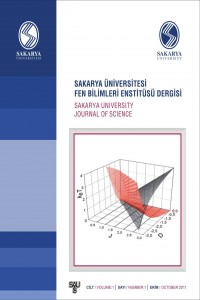Joining of Materials with Diferent Properties Through Submerged Arc Welding Process and Destructive and Non-Destructive Testing of the Joints
Abstract
In this study, X60, X65 and X70 steels used in petroleum and natural gas pipeline were joined with Submerged Arc Welding by using different type of welding fluxes (LN761 and P223) and wires (S1 and S2Mo). Initially, visual and radiographic inspection techniques were subjected to welded joints for determining surface and subsurface defects. After that, spectral analyses were carried out in order to determine the compositions of wire-flux-base metal on the joints. Impact toughness test were performed for determining toughness properties the joints. Furthermore, hardness and microstructure studies were also * Sorumlu Yazar / Corresponding Authorcarried out on the samples. As a result of the visual and radiographic inspection on the welded samples, there were no weld defects on joints were observed. It was clearly understood that carbon ratio in the compositions of weld metal higher than base metal but lower than filler metal in terms of spectral analyses results. According to impact toughness test results, the joints obtained by using S2Mo welding wire and P223 welding flux had better impact toughness value than the joints obtained by S1 welding wire and LN 761 welding flux. With respect to hardness test, the highest hardness values were measured on weld metal. When the microstructure images were examined, it is clearly understood that similar images for all the joints were shown adjacent zones to weld metals heat affected zones and welding boundary, due to heat input constant.
References
- ADA, H., Petrol ve doğalgaz boru hatları için üretilen boruların Tozaltı ve spiral kaynak yöntemiyle kaynaklanabilirliği ve mekanik özelliklerinin incelenmesi, Gazi Üniversitesi, Fen Bilimleri Enstitüsü Yüksek Lisans Tezi, Ankara, 2006.
- AKAY, A. A., Farklı özellikteki malzemelerin tozaltı ark kaynak yöntemi ile birleştirilmesi ve birleştirmelerin tahribatlı ve tahribatsız muayenesi, Karabük Üniversitesi, Fen Bilimleri Enstitüsü Yüksek Lisans Tezi, Karabük, 2012.
- ERENGİN, A., Ark esaslı kaynak yöntemleriyle yapılan uygulamalarda, kutuplama durumu ile ilave malzeme-ergime verimi ilişkisinin incelenmesi, Yıldız Teknik Üniversitesi, Fen Bilimleri Enstitüsü Yüksek Lisans Tezi, İstanbul, 2009.
- KAYA, Y., KAHRAMAN, N., DURGUTLU, A., GÜLENÇ, B., Ferritik paslanmaz çelik ile düşük karbonlu çelik malzemelerin farklı kaynak yöntemleriyle birleştirilebilirliğinin araştırılması,
Farklı Özellikteki Malzemelerin Tozaltı Ark Kaynak Yöntemi ile Birleştirilmesi ve Birleştirmelerin Tahribatlı ve Tahribatsız Muayenesi
Abstract
In this study, X60, X65 and X70 steels used in petroleum and natural gas pipeline were joined with Submerged Arc Welding by using different type of welding fluxes (LN761 and P223) and wires (S1 and S2Mo). Initially, visual and radiographic inspection techniques were subjected to welded joints for determining surface and subsurface defects. After that, spectral analyses were carried out in order to determine the compositions of wire-flux-base metal on the joints. Impact toughness test were performed for determining toughness properties the joints. Furthermore, hardness and microstructure studies were also carried out on the samples. As a result of the visual and radiographic inspection on the welded samples, there were no weld defects on joints were observed. It was clearly understood that carbon ratio in the compositions of weld metal higher than base metal but lower than filler metal in terms of spectral analyses results. According to impact toughness test results, the joints obtained by using S2Mo welding wire and P223 welding flux had better impact toughness value than the joints obtained by S1 welding wire and LN 761 welding flux. With respect to hardness test, the highest hardness values were measured on weld metal. When the microstructure images were examined, it is clearly understood that similar images for all the joints were shown adjacent zones to weld metals heat affected zones and welding boundary, due to heat input constant.
References
- ADA, H., Petrol ve doğalgaz boru hatları için üretilen boruların Tozaltı ve spiral kaynak yöntemiyle kaynaklanabilirliği ve mekanik özelliklerinin incelenmesi, Gazi Üniversitesi, Fen Bilimleri Enstitüsü Yüksek Lisans Tezi, Ankara, 2006.
- AKAY, A. A., Farklı özellikteki malzemelerin tozaltı ark kaynak yöntemi ile birleştirilmesi ve birleştirmelerin tahribatlı ve tahribatsız muayenesi, Karabük Üniversitesi, Fen Bilimleri Enstitüsü Yüksek Lisans Tezi, Karabük, 2012.
- ERENGİN, A., Ark esaslı kaynak yöntemleriyle yapılan uygulamalarda, kutuplama durumu ile ilave malzeme-ergime verimi ilişkisinin incelenmesi, Yıldız Teknik Üniversitesi, Fen Bilimleri Enstitüsü Yüksek Lisans Tezi, İstanbul, 2009.
- KAYA, Y., KAHRAMAN, N., DURGUTLU, A., GÜLENÇ, B., Ferritik paslanmaz çelik ile düşük karbonlu çelik malzemelerin farklı kaynak yöntemleriyle birleştirilebilirliğinin araştırılması,
Details
| Primary Language | Turkish |
|---|---|
| Subjects | Engineering |
| Journal Section | Research Articles |
| Authors | |
| Publication Date | April 1, 2013 |
| Submission Date | December 27, 2012 |
| Acceptance Date | January 26, 2013 |
| Published in Issue | Year 2013 Volume: 17 Issue: 1 |
Cite
INDEXING & ABSTRACTING & ARCHIVING
Bu eser Creative Commons Atıf-Ticari Olmayan 4.0 Uluslararası Lisans kapsamında lisanslanmıştır .


